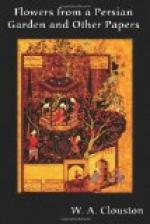[33] This story has been taken from
Arab Shah into the
Breslau
printed Arabic text of the Thousand and One
Nights,
where it is related at great length. The
original
was rendered into French under the title of
“Ruses
des Femmes” (in the Arabic Ked-an-Nisa,
Stratagems
of Women) by Lescallier, and appended to his
version
of the Voyages of Sindbad, published at Paris in
1814,
long before the Breslau text of The Nights was
known
to exist. It also forms part of one of the Persian
Tales
(Hazar u Yek Ruz, 1001 Days) translated by Petis
de
la Croix, where, however, the trick is played on the
kazi,
not on a young merchant.
IV
ASHAAB THE COVETOUS—THE STINGY MERCHANT
AND THE HUNGRY BEDOUIN—THE
SECT OF SAMRADIANS—THE STORY-TELLER AND
THE KING—ROYAL GIFTS TO
POETS—THE PERSIAN POET AND THE IMPOSTOR—“STEALING
POETRY”—THE RICH
MAN AND THE POOR POET.
Avaricious and covetous men are always the just objects of derision as well as contempt, and surely covetousness was quite concentrated in the person of Ashaab, a servant of Othman (seventh century), and a native of Medina, whose character has been very amusingly drawn by the scholiast: He never saw a man put his hand into his pocket without hoping and expecting that he would give him something. He never saw a funeral go by, but he was pleased, hoping that the deceased had left him something. He never saw a bride about to be conducted through the streets to the house of the bridegroom but he prepared his own house for her reception, hoping that her friends would bring her to his house by mistake. If he saw a workman making a box, he took care to tell him that he was putting in one or two boards too many, hoping that he would give him what was over, or, at least, something for the suggestion. He is said to have followed a man who was chewing mastic (a sort of gum, chewed, like betel, by Orientals as a pastime) for a whole mile, thinking he was perhaps eating food, intending, if so, to ask him for some. When the youths of the town jeered and taunted him, he told them there was a wedding at such a house, in order to get rid of them (because they would go to get a share of the bonbons distributed there); but, as soon as they were gone, it struck him that possibly what he had told them was true, and that they would not have quitted him had they not been aware of its truth; and he actually followed them himself to see what he could do, though exposing himself thereby to fresh taunts from them. When asked whether he knew anyone more covetous than himself, he said: “Yes; a sheep I once had, that climbed to an upper stage of my house, and, seeing a rainbow, mistook it for a rope of hay, and jumping at it, broke her neck”—whence “Ashaab’s sheep” became proverbial among the Arabs for covetousness as well as Ashaab himself.




